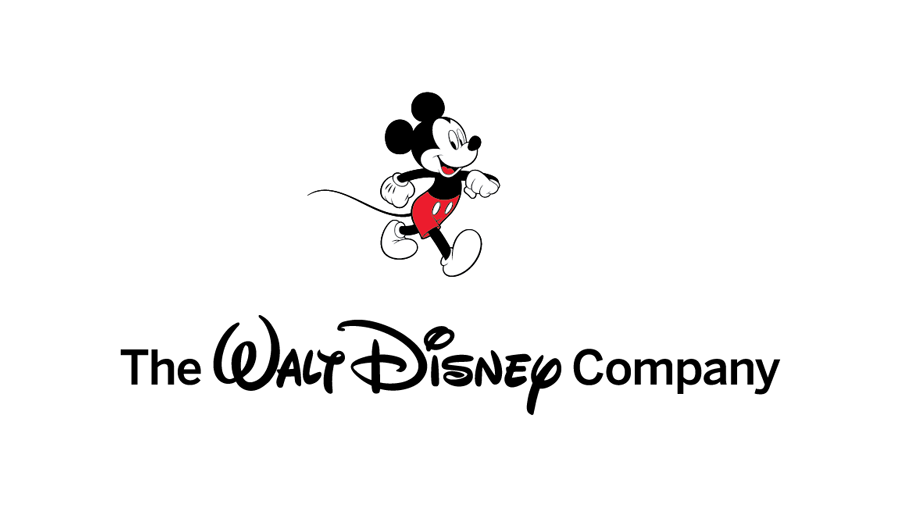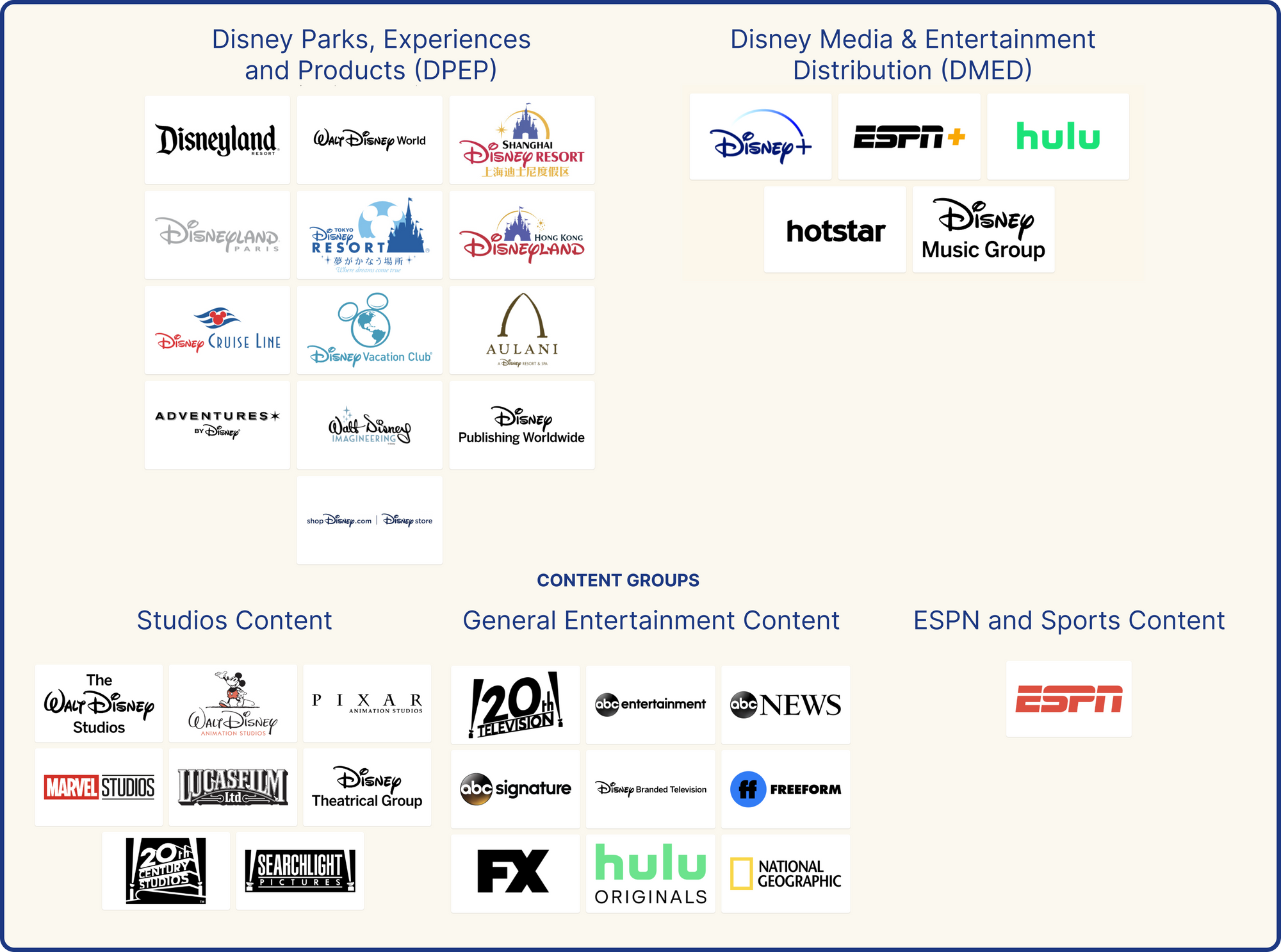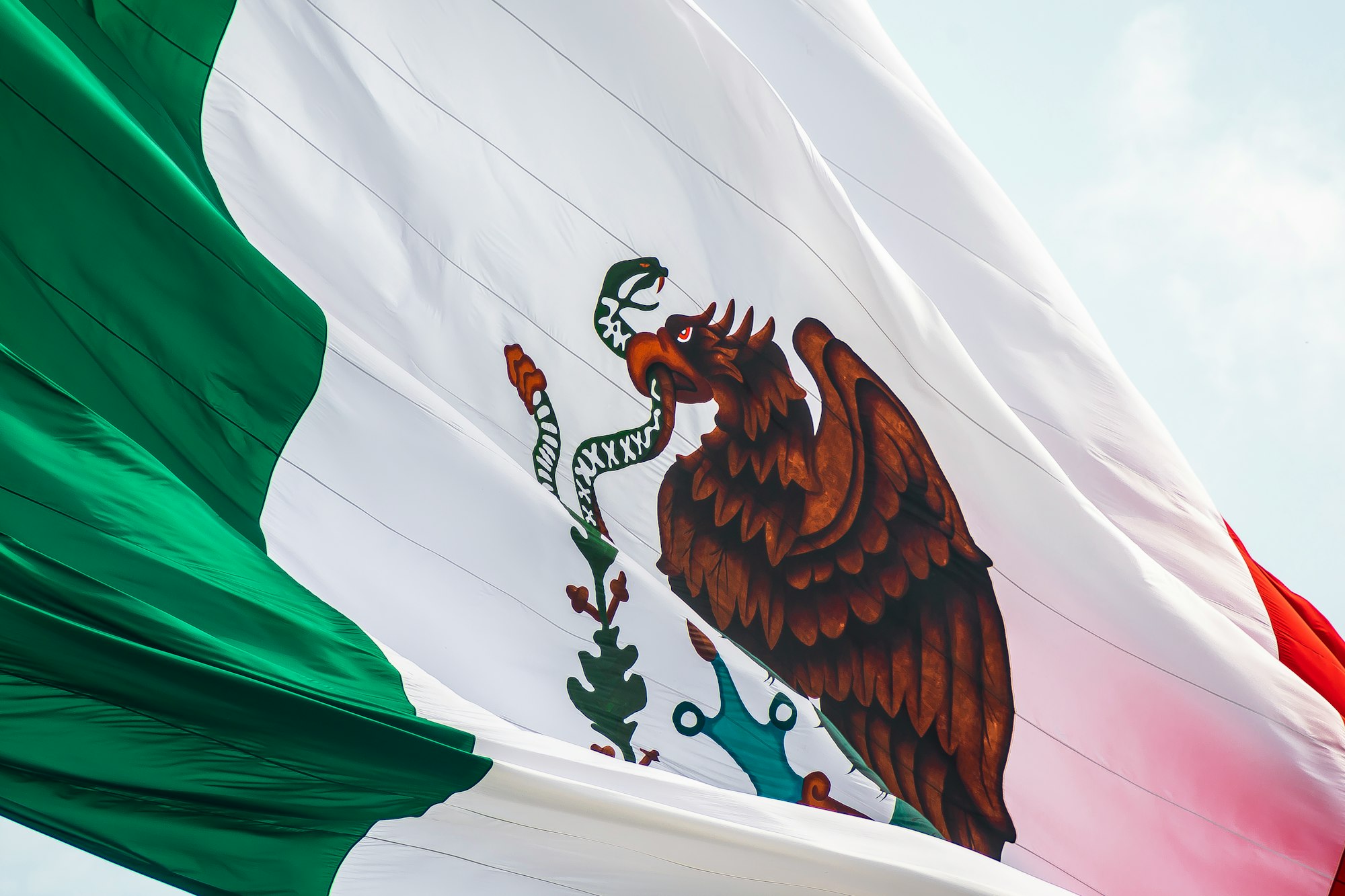The Walt Disney Company is an American entertainment company active in mass media and entertainment. The company is headquartered at the Walt Disney Studios complex in Burbank, California. It operates in media networks, parks and resorts, studio entertainment, consumer products and interactive media. Today, the company employs approximately 190,000 people and generated annual revenues of $67 billion and a net income of $4 billion in 2021.
Publicly traded since 1940, Disney is part of the Dow Jones Industrial Average and trades on the New York Stock Exchange (NYSE) under the ticker code DIS.
- The company was founded by Walt and Roy Disney on October 16, 1923 as the Disney Brothers Studio
- In 1928, the first animated film to star Mickey Mouse debuted in New York, the film was an immediate sensation and led to the studio’s dominance in the animated market
- In the 1930s and 1940s, the studio booked multiple successes with the production of Snow White and the Seven Dwarfs (1937), Pinocchio (1940), Dumbo (1941) and Bambi (1942)
- In 1955, the first theme park Disneyland was opened in California
- The Disney Company continued to flourish during the 1950s and 1960s producing quality animated movies such as Sleeping Beauty (1959), 101 Dalmatians (1961), and Winnie the Pooh and the Honey Tree (1965)
- The company declined after Disney’s death in 1966 but was revitalized under a new management in the 1980s
- In 1996, Disney acquired the ABC television network for $19B and became the world’s largest media and entertainment corporation
- In 2009, Disney acquired Marvel Entertainment
- In 2019, the company acquired 20th Century Fox and launched its streaming service Disney+
- Today, The Walt Disney Company is led by Bob Chapek while former CEO and Chairman Bob Iger assumes the role of Executive Chairman

A WELL DIVERSIFIED HOLDING
The Walt Disney Company is a diversified global entertainment company with operations in two segments: (i) Disney Media and Entertainment Distribution (DMED) and (ii) Disney Parks, Experiences and Products (DPEP).
(i) Disney Media and Entertainment Distribution (DMED):
- The DMED segment encompasses Disney’s global film and episodic television content production and distribution activities
- The segment accounted for 75% of Disney's 2021 revenues, or $50.9B
- Content is distributed across three lines of business: (a) Linear Networks distribution such as ABC Television, ESPN and National Geographic, (b) Direct-to-Consumer distribution such as Diney+, Hulu and ESPN+ and (c) Content Sales and Licensing distribution which include the sale of content to third-party television or theatrical distribution
- Content is created by three groups: (a) Studios which include films produced under the Walt Disney Pictures, Twentieth Century Studios, Marvel, Lucasfilm, Pixar and Searchlight Pictures banners, (b) General Entertainment such as the rights to and internal production of television programs and news content and (c) Sports such as professional and college sports programming rights and related productions
(ii) Disney Parks, Experiences and Products (DPEP):
- The segment accounted for 25% of Disney's 2021 revenues, or $16.5B
- Parks & Experiences mainly consists of theme parks and resorts: the Walt Disney World Resort in Florida, Disneyland Resort in California, Disneyland Paris, Hong Kong Disneyland Resort (48% ownership interest), Shanghai Disney Resort (43% ownership interest). Additionally, Disney licenses IP to a third party to operate Tokyo Disney Resort
- Consumer Products includes the licensing of Disney's trade names, characters, visual, literary and other IP to various manufacturers, game developers, publishers and retailers throughout the world, for use on merchandise, published materials and games. Branded merchandise is sold through retail, online and wholesale businesses

THE WORLD'S 7TH MOST VALUABLE BRAND
Disney is one of the biggest, most valuable and most well-known companies in the world. In Forbes' list of the 2020 most valuable brands, Disney ranked 7th, just behind The Coca Cola Company, and 53rd in the 2022 Fortune 500 ranking.
In the past, Disney has been recognized as the world’s most powerful brand in 2016 by Brand Finance who noted that the Company’s strength is “founded on its rich history and original creations, however its now dominant position is the result of its many acquisitions and the powerful brands it has brought under its control.”
THE RISE, THE FALL AND THE RENAISSANCE
By the early 1950s, The Walt Disney Company had achieved significant success by diversifying into live-action movies, television, and amusement parks. However, after Walt Disney death in 1966, the company's profitability started to fall and more particularly in the animation section.
In the 1980s, the company's brand assets, which included the film library and the theme parks, were deemed to be so undervalued that hostile takeover started to emerge. The corporation resisted the takeover attempts and switched its attention to maximizing the value of its significant brand equity.
Disney's underperforming animation studios were revitalized during Eisner's 21-year tenure from 1984 to 2005. This period is known as the Disney Renaissance, thanks to blockbuster movies like The Little Mermaid (1989), Beauty and the Beast (1991), Aladdin (1992), and The Lion King (1994). Additionally, Eisner expanded the company's media portfolio by spearheading the purchases of ABC, the majority of ESPN, and The Muppets brand.
MORE VIEWERS THAN NETFLIX
Disney's dominance over Netflix has grown in recent years as Disney+, Hulu, and ESPN+ have now surpassed Netflix in terms of viewership, marking the success of Dineys's five-year effort to enter the digital streaming market.
- According to Disney's latest quarterly earnings figures, Disney+ subscriptions increased to 152.1 million, exceeding the 147 million analysts' expectations
- ESPN+ had 22.8 million subscribers and Hulu had 46.2 million
- Combined, the three streaming services now have more than 221 million subscribers while Netflix, which has long been the streaming leader, had 220 million users
The streaming space has been going through a lot of turmoil in recent months. Warner Bros. Discovery revealed a change in content strategy, and Netflix revealed yet another decline in subscribers.
- To boost its subscribers count and profitability, Netflix is launching a new ad-supported plan that may cost between $7 and $9 per month, the current ad-free streaming service offer costs $10 per month
- Disney has also made recent announcements of new ad-supported offerings, Disney+ with commercials will be $8 per month while the price of ad-free Disney+ will rise 38% to $11
THE MARKET
According to the U.S. International Trade Administration, the U.S. Media and Entertainment (M&E) industry is the largest in the world at $660 billion (of the $2 trillion global market).
- The market is divided into an (i) online channel (movies, streaming video, theatrical productions, radio, music, digital signage, theatrical productions, and gaming) and an (ii) offline channel (amusement and theme parks).
The global video streaming market size was valued at $372 billion in 2021 and is expected to grow from $473 billion in 2022 to $1,7 trillion by 2029, representing a CAGR of 20% over the period.
- Due to the presence of dominant players such as Netflix, Disney and Amazon Prime, the U.S. and Canada hold the largest market share for video streaming
- Additionally, the growing number of users of video on demand and gaming platforms contributes to the market's expansion
- Key players of the media and entertainment market that Disney is competing with include Warner Bros, Sony Pictures Entertainment Inc., Paramount Pictures, Netflix, Amazon Prime and Apple.
The market for amusement parks is anticipated to grow at a CAGR of 6.2% from 2020 to 2025 and reach $72 billion.
- Theme parks provide a wide range of entertainment options and serve as a one-stop leisure and entertainment solution
- The market growth is largely being driven by the growing number of baby boomers who are retiring and who are spending money on recreation and leisure
- Theme parks further benefit from the expanding global tourist industry
EXPERIENCED MANAGEMENT
The Walt Disney Company is led by Bob Chapek who is assuming the role of CEO since February 2020. Chapek is Disney's 7th CEO in the company's 100-year history.
- Bob Chapek is Chief Executive Officer of Disney and has nearly three decades of experience within the firm
- Before becoming CEO, Mr. Chapek served as Chairman of Disney Parks, Experiences and Products since the segment’s creation in 2018. Prior to that he was Chairman of Walt Disney Parks and Resorts since 2015
- Holds a degree in microbiology from Indiana University Bloomington, and received his MBA from Michigan State University
- Alan Bergman serves as Chairman of Disney Studios Content and the Studios division, which encompasses a collection of entertainment studios that produce cinematic storytelling for both theatrical and streaming release
- Bergman joined The Walt Disney Company in 1996 as a Director in the corporate controllership group with a focus on Walt Disney Studio. Bergman served as Co-Chairman of The Walt Disney Studios from 2019 to 2020 and as its President from 2005 to 2019
- Holds a bachelor’s degree in business economics from UCLA
- Christine McCarthy is Senior Executive Vice President and Chief Financial Officer of Disney since 2015 and oversees the company’s worldwide finance organization
- Prior to becoming CFO of The Walt Disney Company in 2015, Ms. McCarthy served as Executive Vice President, Corporate Real Estate, Alliances and Treasurer
- Completed her Bachelor’s Degree in Biological Sciences at Smith College and earned an MBA from the Anderson School at UCLA
TAKE A BREATH
So… This is a lot of information. Let’s summarise:
- The Walt Disney Company is an American entertainment company active in mass media and entertainment headquartered in Burbank, California
- The company employs approximately 190,000 people and generated annual revenues of $67 billion and a net income of $4 billion in 2021
- The Disney Media and Entertainment Distribution (DMED) segment encompasses Disney’s global film and episodic television content production and distribution activities, it accounted for 75% of Disney's 2021 revenues, or $50.9B
- The Disney Parks, Experiences and Products (DPEP) segment accounted for 25% of Disney's 2021 revenues, or $16.5B
- Disney is one of the biggest, most valuable and most well-known companies in the world, it ranked 7th in the Forbes' list of the 2020 most valuable brands
- Disney+, Hulu, and ESPN+ have now surpassed Netflix in terms of viewership with over 221 million subscribers
- The U.S. Media and Entertainment (M&E) industry is the largest in the world at $660 billion out of a $2 trillion global market
- The Walt Disney Company is led by Bob Chapek as CEO since February 2020, Chapek is Disney's 7th CEO in the company's 100-year history
FINANCIAL CHECK
Disney grew revenues by 26% year-on-year to $21.5B in the third quarter of 2022 on the back on strong streaming subscribers growth and increased spending at its theme parks.
- Earnings per share: 77 cents a share (profits of $1.41 billion, up from $918 million) vs 50 cents a share, in the prior-year quarter
- Revenue: $21.5B from $17.0B in the prior-year quarter
- Disney+ total subscriptions: 152.1m after an addition of 14.4m Disney+ subscribers in Q3 2022
- Disney Media and Entertainment Distribution division (DMED) increased revenue by 11% to $14.1B during the quarter (vs $12.7B during Q3 2021)
- Disney Parks, Experiences and Products division (DPEP) increased revenue by 72% to $7.4B during the quarter (vs $4.3B during Q3 2021) mainly due to increases in attendance, occupied room nights and cruise ship sailings
- Q3 2022 saw a 10% increase in per capita spending at domestic parks compared to Q3 2021 and was 40% higher than in Q3 2019
THE BOTTOM LINE
The Good
- Disney has succesfully entered the digital streaming market and is now ahead of industry leader Netflix, Disney is now increasing its focus on international markets to further boost growth
- While Disney's theme parks have not run at full capacity since the pandemic, demand has been strong and revenue generated per visitor has increased compared to 2019
The Bad
- If economic conditions worsen and inflation persists, consumers could cut back on subscription spending and theme parks visits
- Disney ad-supported subscription represents a major strategy shift and could negatively affect the consumer experience if wrongly implemented
Disclaimer
Please note that this article does not constitute investment advice in any form. This article is not a research report and is not intended to serve as the basis for any investment decision. All investments involve risk and the past performance of a security or financial product does not guarantee future returns. Investors have to conduct their own research before conducting any transaction. There is always the risk of losing parts or all of your money when you invest in securities or other financial products.
Credits
Photo by Pan Xiaozhen on Unsplash






